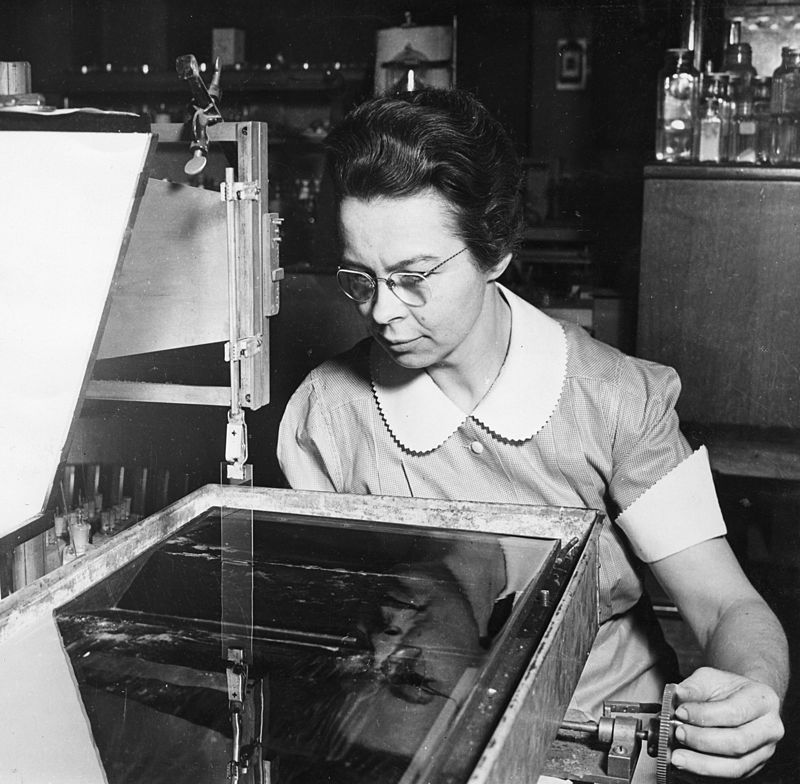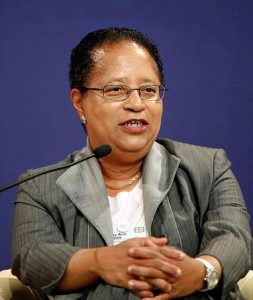Female Physicists in History



Jill S. Tietjen, PE, is an author, national speaker, and…
To much of the American public physics is a mystery, but not to the women we are profiling this month. To them, physics was fascinating and a means of not only having a satisfying career but providing exceptional value to the world as well. Among the women physicists we profile are Nobel Laureates and inductees into the National Inventors Hall of Fame and the National Women’s Hall of Fame.

Physicist Katharine Blodgett was working at General Electric when she invented non-reflective glass. The first female scientist hired by GE, Blodgett filed for her patent in 1939 and received it in 1940. One of the first uses of the non-reflective glass was for the camera lenses that filmed the movie Gone with the Wind. The glass is used today in many applications including on our laptops, televisions, and smartphones. Blodgett received a total of eight patents over the course of her career. She worked on improvements to the light bulb involving electric discharges of gases; this laid the foundation for the field of plasma physics. Blodgett also invented the color gauge to measure molecular coatings on glass to the millionth of an inch. Her work during World War II included poison gas adsorbents, methods of deicing airplane wings, and improved smokescreens. In 2007, Blodgett was inducted into the National Inventors Hall of Fame.

Nuclear physicist Chien-Shiung Wu came to the United States from China to pursue graduate studies at the University of California at Berkeley. Her father was an advocate of gender equity and ensured that she was ‘properly’ educated. Wu received her Ph.D. in 1940. From 1942 on, she served on the faculty at several universities and was involved in the Manhattan Project – the successful effort by the U.S. to develop the atomic bomb. During her years at Columbia University, Wu performed an experiment that confirmed that the “Law of Conservation of Parity” did not hold up in nature. The two men that developed the theory received the 1957 Nobel Prize in Physics; Wu was not selected to share in that Prize, although she did receive the Wolf Prize and many other honors for her work. Wu was the first living scientist to have an asteroid named after her. She was the first Chinese-American person to be elected to the National Academy of Sciences, the first female instructor in the Department of Physics at Princeton University, the first woman to receive an honorary doctorate from Princeton University, and the first female president of the American Physical Society. Wu has been inducted into the National Women’s Hall of Fame.

In 1963, Maria Goeppert-Mayer became the first U.S. woman to receive the Nobel Prize in Physics. Recognition came after many years when she had worked as a “volunteer” – due to nepotism rules in place at the time. This principle meant that both spouses could not be hired with pay at the same institution. After meeting Enrico Fermi at Columbia University, she, like Wu, became one of the nuclear physicists on the Manhattan Project. After the war, Goeppert-Mayer moved to Chicago to be a senior physicist at Argonne National Laboratory – the first time she had a position on equal footing with her colleagues. At Argonne, Goeppert-Mayer began studying unusually stable elements and found patterns that she called “magic numbers”. From these, she developed the theory of the shell model for the nucleus in conjunction with spin-orbit coupling. For this theory, she was awarded the Nobel Prize. Goeppert-Mayer has been inducted into the National Women’s Hall of Fame.

Betsy Ancker-Johnson grew up in a family where her interest in math and science was encouraged. Her junior high school, however, was not so accommodating. She was not allowed to take shop class; instead, she had to enroll in home economics. Although she wanted to attend the Massachusetts Institute of Technology, she did study physics at Wellesley College, one of only two students selecting that major. From Wellesley, she earned her PhD at the University of Tübingen in Germany where she was the only female student in the physics department. She married mathematician Harold Hunt Johnson in 1958 saying he was “the first man I ever met who thoroughly understood that my interest in electrons was as great as his in partial differential equations of the umpteenth order.” During her career, Ancker-Johnson worked at a variety of corporations, universities and in government. In 1973, President Nixon appointed her assistant secretary of commerce where she was responsible for science and technology. In that job, she supervised 7,500 employees and an annual budget of $230 million. In 1979, she became the first female vice president at General Motors. She served in that role until 1992. In 1993, she helped prepare a report for the National Academy of Sciences on the underrepresentation of women in scientific and engineering jobs. In retirement, she competed internationally in masters swimming meets.

The second woman to receive the Nobel Prize in Physiology or Medicine, Rosalyn Yalow was honored in 1977 for her work as the co-discoverer of radioimmunoassay, an extremely sensitive way to measure insulin and other hormones in the blood. The technique invigorated the field of endocrinology. It also made possible major advances in diabetes research and in the diagnosis and treatment of hormonal problems related to growth, thyroid function and fertility. The daughter of parents who had not finished high school, Yalow entered Hunter College in New York City as their first physics major. She later earned her PhD in nuclear physics. She told interviewers that she had known from the time she was 8 years old that she wanted to be a scientist. She studied physics after reading Eve Curie’s biography of her mother Madam Marie Curie, the two-time Nobel Laureate. Yalow has been inducted into the National Women’s Hall of Fame.

Nuclear physicist Shirley Ann Jackson became the president of Rensselaer Polytechnic Institute in 1999. The first African-American woman to receive a PhD degree – in any field – from the Massachusetts Institute of Technology, she is the first African-American woman to lead a top-ranked research university. A trailblazer throughout her career, Jackson has held senior leadership positions in academia, government, industry and research. Jackson was appointed by President Clinton to chair the U.S. Nuclear Regulatory Commission. Earlier in her career, she worked for AT&T Bell Laboratories and Rutgers University. The citation accompanying her 2014 National Medal of Science reads: “For her insightful work in condensed matter physics and particle physics, for her science-rooted public policy achievements, and for her inspiration to the next generation of professionals in the science, technology, engineering and math fields.” Her many additional honors include induction into the National Women’s Hall of Fame.
Women participate and contribute to every area of our lives. These physicists, as well as many others, almost all of whom we have not heard about nor learned about in school, are profiled in our book, Her Story: A Timeline of the Women Who Changed America. Help us by continuing to tell women’s stories. Write women back into history! Tell young women especially, that their dreams in any field of endeavor or interest, can become a reality.
Author: Jill Tietjen
Jill S. Tietjen, PE, is an author, national speaker, and an electrical engineer. After 40 years in the electric utility industry, her professional focus is now on women’s advocacy, worldwide. She blogs for The Huffington Post, speaks nationally on the accomplishments of women, nominates women for awards, and continues to write books (8 published to date), following in the footsteps of her bestselling and award-winning book, Her Story: A Timeline of the Women Who Changed America (written with Charlotte Waisman). She is a frequent keynote speaker as her positive energy and her ability to relate to the audience result in inspired and energized listeners. The recipient of many awards, her induction into the Colorado Women’s Hall of Fame in 2010 remains one of her most treasured.

Jill S. Tietjen, PE, is an author, national speaker, and an electrical engineer. After 40 years in the electric utility industry, her professional focus is now on women’s advocacy, worldwide. She blogs for The Huffington Post, speaks nationally on the accomplishments of women, nominates women for awards, and continues to write books (8 published to date), following in the footsteps of her bestselling and award-winning book, Her Story: A Timeline of the Women Who Changed America (written with Charlotte Waisman). She is a frequent keynote speaker as her positive energy and her ability to relate to the audience result in inspired and energized listeners. The recipient of many awards, her induction into the Colorado Women’s Hall of Fame in 2010 remains one of her most treasured.


